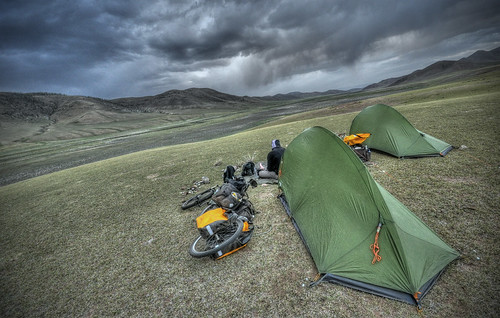Extrawheel’s original Classic model, with its cargo nets and canoeists’ drybags, is no longer in production. Why? Because Extrawheel, after a lot of prototype-testing and feedback by myself and other intrepid riders, have hit upon something that’s even simpler, lighter and more practical: the Voyager.
The Voyager was launched last year and I’ve been able to put it through its paces in some of the toughest conditions I’ve ridden. Carrying a pair of big, waterproof panniers, the Voyager excels when taken off-road, and mine has now been through a couple of thousand miles of dirt roads, singletracks, jeep trails, river-beds and no-track-at-all cross-country riding.
Construction
The improvements over the original Classic trailer are immediately obvious. The plastic-and-fabric hood has now gone, replaced by an optional lightweight fender (which I removed for weight-saving and simplicity). The amount of metal in the frame has been halved. It’s so simple it seems ridiculous that nobody thought of it before! The whole thing fits into a standard bike box — along with the bike itself! Extrawheel’s claim to have produced the world’s lightest single-wheel trailer seems to be well-founded.
Coupling with the bike is done using the original sprung-steel fork, which I have found to be 100% reliable. The bearing surfaces have been redesigned so that the ball and socket can each be replaced, rather than having to replace the whole frame or fork if the bearing surfaces wore through (as happened to me in Ethiopia in 2009). From a durability point-of-view in the long term, this is a big plus point.
The reduced-size frame now features narrow-gauge steel tubing and retainer tabs for mounting panniers, instead of the previous net-and-sack arrangement. This means that packing and quick access is far more practical, the load is more stable as a result, although the bike can no longer be jack-knifed to stand up if rear panniers are used as well. The supplied Crosso Expert panniers, fully-waterproof and constructed of durable laminated canvas, are easily big enough to carry everything I desired to put on the trailer — in Mongolia, that was everything except food, tent and tripod.
Handling
As with the Classic, the handling of the bike benefits greatly off-road from the fact that front panniers are no longer needed — now you can carry luggage and steer it as well! I found the greatest stability with about a 70:30 ratio of weight on the trailer and in the rear panniers respectively. This balance was ideal in terms of manoeuvrability and capacity; the two main factors when heading off the beaten track for long periods of time.
Riding singletrack demonstrated the trailer’s limits. I found that on particularly technical sections, where I was still able to ride the bike itself, the panniers sometimes bounced off obstacles which were bigger than the panniers’ ground clearance allowed for. I encountered similar problems when the track became really narrow — but these were hiking trails after all. I can’t blame the trailer for my route choices!
If there’s anything that could be improved, it would be to add ‘off-road’ tubing, in addition to the standard tubes, to allow the panniers to be mounted a few inches higher, or even allow for extra ‘rack-top’ luggage to be strapped on. This would considerably extend the trailer’s range into mountain-biking territory, and allow the load to be repositioned lower for more stability when appropriate. Perhaps this would work well in a hypothetical 29-er setup (i.e. a bike and trailer with 29-inch wheels).
The original trailer’s other plus-points still apply. Wear and tear on the bike itself is massively reduced. You get a spare front wheel — also meaning spare spokes, bearings and a rim for the back wheel, of course. It’s compact enough to cause no additional fuss on public transport. It’s affordable in comparison to the competition, customer service is excellent, and it’s an great source of amusement and interest to everyone you encounter on the road!
Conclusion
It’s probably not optimal for slimline road-touring, but I won’t hesitate to take my Extrawheel Voyager with me on off-road expeditions and to parts of the world where conditions are likely to be tough. Adventurous bikers: Ditch the front panniers, take the strain off your back wheel and ride a bike which makes tough terrain a source of enjoyment, rather than suffering.
Extrawheel have taken a big risk venturing into the specialist trailer market, which was previously dominated by BOB, but their adaptability and ingenuity has paid off in the form of the Voyager, which is the most refined off-road-friendly luggage solution I’ve used to date.






Something to add?